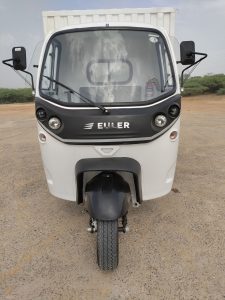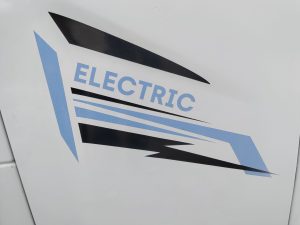The electric small commercial vehicles are offering disruptive technology at an affordable price. Sumesh Soman puts the Euler HiLoad EV through its paces.

At first glance, the Euler HiLoad looks like the big brother of Small Commercial Vehicles (SCVs) out there. The commanding stance in a raised three-wheeler setup and a 0.650-tonne loading container is a testimony to the blurring lines between three-wheeler and four-wheeler cargo solutions in the market. Matching the four-wheelers or at least bravely attempting to do is a feat in itself for Euler Motors. The top speed of the vehicle stands at 45 kmph and boasts of a real-world range of 120 km on a single charge. The HiLoad tips the scales at 1500 kg. A closer look at the front fascia confirms a tastefully built SCV with no compromises on the Total Cost of Ownership (TCO). At an estimated Rs.4,03,987 (Ex-showroom) for the top variant, the Hiload Delivery Van (DV) measures 3400 mm long, 1460 mm wide, 2100 mm tall with a 2200 mm wheelbase and offers a 300 mm ground clearance in an attractive, value for money packaging.
Exteriors
The “Euler” badging is integrated right at the centre of the body cladding and runs right across the front apron to the end below the windshield. And the branding is flanked by halogen projector headlamp units and LEDs on either side. The black and white colour scheme makes it attractive to look at for last-mile delivery assignments be it at dawn or at sunset. Move to the side of the HiLoad, and the doors scream the electric capability through graphics and arc reactor technology. This is quite the industry-first feature to watch out for. The rear largely remains the conventional design housing tail lights on either corners. The departure angle reveals the spare tyre placed right underneath the loading bay. For operators considering the HiLoad, the loading bay can be configured in four ways. Each specification caters to different clients and their respective needs.
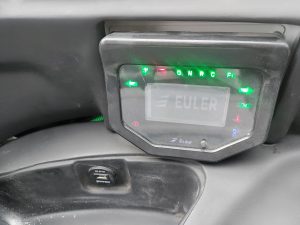
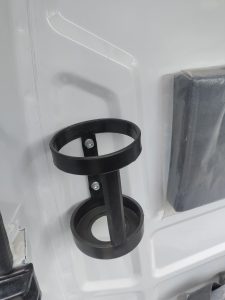
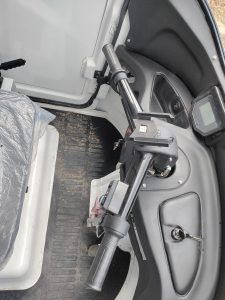
Interiors
Slip into the pilot cockpit and it doesn’t take long to realise the enhanced road view owing to a larger windshield in comparison to the segment’s conventional offerings. This is quite large, aiding the driver with an enormous field of vision. Accompanying me on the drive was the Project Manager, Pranav Khanna, and he explained the reasons behind such enhancements. He said, “Most commercial vehicle accidents or mishaps happen during the night time and 80 per cent of the time it is attributed to obstruction of vision.” Looks like Euler has left no stones unturned here, but more on that later. The A-pillars play a crucial role here. An off-set instrument console is placed on the dashboard along with two cubby holes, one lockable along with a mobile clamp on the steering for the convenience of the driver, and a charging port is integrated into the cubby hole. On the plus side, seating is ample for a driver, but not that generous to accommodate a co-pilot. It will instantly make the cabin hemmed. A fire extinguisher is given to every cabin and a bottle holder is placed next to the driver. The narrow openings to the window flaps and lack of air-con could make summers sultry, especially up North. For the first generation, the cabin is quite spartan, creature comforts are far and few, which is something that vexed me a little. You are forced to sit in an erect position, and the cushioning is adequate. If driver ergonomics are a priority, long hauls could drain the driver and fatigue will set in sooner. Kudos to an agile product lifecycle, Euler Motors, has pro-actively been able to gather customer feedback and is expected to come out with an improved variant, that irons the creases as early as the end of this year. Those looking at means to vent out the stress of plying last mile in city traffic can opt for a music system. Speakers can be integrated into the vehicle by the company itself for a premium of around Rs.2000.
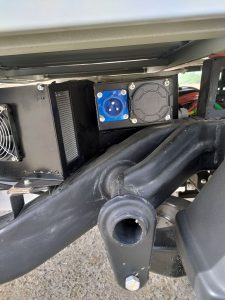
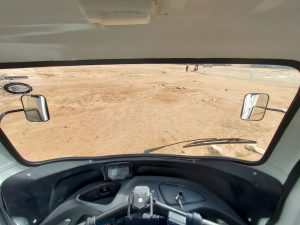
Powertrain
The Euler HiLoad is propelled by a 12.4 kWh lithium-ion battery pack integrated into the chassis to avoid rollover. This has helped in maintaining a low centre of gravity given the application of the vehicle. It is mated to a 10.96 kW motor that puts out 88 Nm of instant torque. The battery is liquid-cooled, a first for the segment. The HiLoad runs on 12-inch wheels with a disc brake upfront and a drum setup at the rear. It is equipped with a hydraulic shock absorber with helical spring for the front wheel and an independent trailing arm for the rear wheels. This makes the suspension work individually for both the wheels and lends to the rollover resistance.

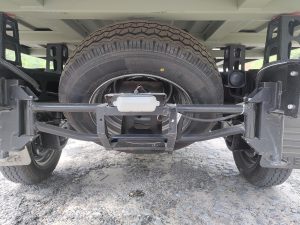

Tech differentiators
The Battery Management System (BMS) christened ‘Arcreactor’ technology, especially with recent events of electric two-wheelers catching fire is a clear differentiator. The liquid cooling system pumps liquid coolant around the battery casing to maintain the optimal temperature. The optimal temperature generally is set at 25 degrees Celsius but can be locally altered to suit customers from different regions. Apart from that, the Euler HiLoad comes with a software package that can receive Over The Air (OTA) updates which ensures that the vehicle remains up to date with the latest software. A feature that impressed me is the ‘Disable Vehicle’ provision, for the fleet owner when suspecting a malified activity to remotely disable the vehicle at the press of a thumb.

Ride quality
The ride quality is quite supple on the tarmac and a little jerky when off-road, and understandably so. Considering how the vehicle is targeted for last-mile delivery in urban metros. In tier markets, it is refined enough to not be a deal-breaker considering how Indian roads are. At a twist of the throttle, 80 Nm of torque is available from the get-go. The torque curve is flat throughout so there is no scarcity of power. A minor lag experienced initially, eventually fades out as one starts getting acquainted with the acceleration inputs and innate response of the vehicle. The brakes do a good job of dropping the anchors when needed, but one has to really work the calf muscles to get them to work, and that is a fly in the ointment especially when you are handling a factory rolled-out, brand new vehicle.
The handlebar is a mechanical one and so are the brakes. In a fully-laden state, the vehicle will make you work up your arm and feet. As the instrument cluster is off-centre, the readouts are not that legible at a glance especially when there is top light. There are no door handles on the inside, and one has to pull up a metal extension to open the door. Get ready for multiple engagements that leave the fingers jaded.
Verdict
The base variant is priced at 3.78 lakh rupees and the top variant stands at 4.08 lakh rupees. At this price you get a vehicle that can haul 0.650-tonne of payload at a speed of 45 kmph with a range of about 125 km. The niggles are not in the performance section, but in the creature comfort area. If the company figures a way out to take care of its drivers with a reasonable premium then the HiLoad can be an even greater disruptor as a whole than it already has proven to be. With the order pipeline as a testimony of the market backing it, it did bag the EV of the year award at the Apollo CV Awards 2022. That does say something for the segment-first benchmarks created by the Euler HiLoad EV.



